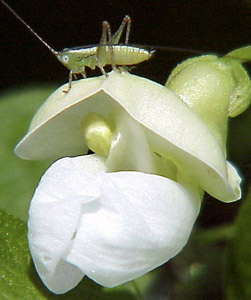Baby Grasshopper

Photo by Steve Nearman
A baby grasshopper, called a "nymph" (less than 1/4 inch long) rest on a green bean flower in above photo. Grasshoppers, in large quantities they can be very destructive.
The life cycle of a grasshopper is one of simple metamorphosis. Young grasshoppers hatch from eggs and resemble small, wingless adults. Grasshoppers shed their skins as they grow, usually molting several times before emerging as winged adults. Most short-horned grasshoppers lay eggs in the soil, but some species place eggs inside plant stems. Male grasshoppers "chirp" to attract females. The familiar chirping sound is produced with a "stridulating organ" located at the base of the wings. Pictured above is a typical nymphs of long-horned and short-horned grasshoppers.
Sometimes when you pick up a grasshopper, dark fluid will come out of the insect's mouth. Because grasshoppers are sometimes found in tobacco, it is sometimes said that this fluid is "tobacco juice", and that the grasshopper is "spitting" at you because it is mad. As it turns out, most grasshoppers can produce this fluid, even if they haven't been eating tobacco. It is not tobacco juice though: it is a defensive chemical produced inside the grasshopper.
Resource: Department of Entomology, University of Kentucky